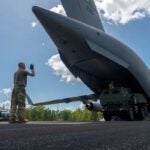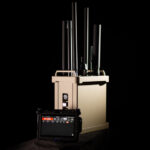Department of the Air Force Posture Hearing. The Senate Armed Services Committee is to hear from newly minted Air Force Secretary Troy Meink, Air Force Chief of Staff Gen. Dave Allvin, and Chief of Space Operations Gen. B. Chance Saltzman on Tuesday at an FY 2026 and future years posture hearing for the Department of the Air Force. One item for discussion will likely be “right-to-repair” provisions that may become part of the fiscal 2026 National Defense Authorization Act—provisions first proposed last December by Sen. Elizabeth Warren (D-Mass.) and Rep. Marie Gluesenkamp Perez (D-Wash.) in their Servicemember Right to Repair bill. This month, Army Secretary Dan Driscoll said that he would ensure that right-to-repair provisions are in future Army contracts and that he would propose modifying existing contracts to include those guidelines. According to Warren, “commanders in the field should never have to beg a contractor to come repair a plane that the Air Force owns or that soldiers could fix themselves.” During his January nomination hearing, Driscoll said that the “type of innovation happening in the private sector at scale in a lot of ways seems to have not trickled into the Army as much” and that “if we think about engagement with a peer like China, being able to repair our parts in areas around the world will be crucial to that.” Driscoll testified that “if we are having six-month delays in CONUS and paying 100x the rate, that is not scalable in an actual conflict.”
CH-53K Maintenance. Fleet Readiness Center East (FRCE) at Cherry Point, N.C., on April 17 inducted the first CH-53K King Stallion helicopter for depot-level maintenance. The helicopter arrived on April 4 from Marine Heavy Helicopter Squadron 461 (HMH-461) onboard Marine Corps Air Station New River. This is the first of 15 helicopters FRCE will perform routine maintenance on as part of the Age Exploration Program, Depot (AEPD). AEPD collects information on an aircraft’s condition via controlled testing and analysis and assists in the development of effective and efficient maintenance schedules for new aircraft. Jeff Warren, CH-53K capability establishment lead at FRCE, also noted the 14 CH-53K industries at this facility will help determine the aircraft class’s overall planned maintenance interval. The second CH-53K is planned to arrive for maintenance in late 2026, with the third and fourth aircraft in fiscal year 2027.
AUKUS Office. Rear Adm. Richard Seif assumed management of the AUKUS Integration and Acquisition Direct Reporting Program Management Office on April 21, according to a May 14 Navy announcement. Seif previously served as commander of the Submarine Force at the U.S. Pacific Fleet and commander of Task Force 34 in Pearl Harbor, Hawaii. Seif succeeds Rear Adm. Lincoln M. Reifsteck, who now serves as commander of Submarine Group Seven, Task Force-54 and Task Force-74. This office is responsible for executing the trilateral AUKUS agreement to help Australia acquire nuclear-powered submarines with high nuclear stewardship and nonproliferation standards.
Golden Dome Study. During a May 13 Senate Armed Services Committee hearing, acting principal deputy assistant secretary of defense for Space Policy Andrea Yaffe confirmed the Defense Department delivered the initial 30-day review on Golden Dome development pathways to the White House in line with the original Jan. 27 executive order. She said DoD officials worked with stakeholders to work on the different design options and “we matured them to a place that the technical experts took over and really refined them into a few different options to bring to the secretary.” She added DoD leaders have engaged with the president on this “and the hope is that there will be an announcement soon, certainly tied with the budget.”
…Includes Current Systems. Gen. Gregory Guillot, commander of Northern Command and NORAD, said he does not know what Golden Dome will ultimately look like “but I suspect that it would be able to use a lot of the systems that are already in place and currently in development, which would give us a full capability in probably something closer to zero to five years, as opposed to something a decade out into the future.” he said this includes Hypersonic and Ballistic Tracking Space Sensor (HBTSS), space-based Air Moving Target Indicator (AMTI) with prototypes on orbit now, over the horizon radars, and the Boeing E-7 Wedgetail airborne early warning and control aircraft.
Doubling the Budget. The U.S. Space Force’s fiscal 2025 funding of about $29 billion is about 3.4 percent of the nearly $850 billion DoD pie, and Chief of Space Operations Gen. B. Chance Saltzman has called for another $10 billion for the service soon. Now, Lt. Gen. Shawn Bratton, the deputy chief of space operations for strategy, plans, programs, and requirements, says that a doubling of the Space Force budget is warranted, especially given the service’s new space warfighting mission, and that such a doubling would not account for areas like Golden Dome, cislunar missions, or satellite refueling. Bratton says that the service “costed out” OSD’s Defense Planning Guidance requirements on the Space Force. “To do all the things that the department is telling the Space Force they expect us to do, it about doubles our budget,” he says. “That’s an over time thing, though quite honestly they’re asking us to do it today. I think we’ve laid out a pretty good case with a lot of space superiority. The warfighting stuff is new kit that didn’t exist, and we’ve tried to stop doing some of the old stuff and been told pretty directly you will keep doing missile warning/SATCOM/positioning, navigation, and timing. You have to keep doing these old missions. This new mission requires new money.” A congressional DoD reconciliation bill may provide the Pentagon with $113 billion more funding, and it looks as if the overall DoD budget request for fiscal 2026 may be flat.
Turkey FMS. The State Department on May 14 approved two potential Foreign Military Sales with Turkey, a $225 million deal for AIM-120C-8 Advanced Medium-Range Air-to-Air Missiles (AMRAAM) and a $79.1 million sale of AIM-9X Sidewinder Block II missiles. The former deal includes 53 of RTX’s AIM-120C-8 AMRAAMs and six guidance sections, while the latter covers 60 of RTX’s AIM-9X Sidewinder Block IIs and 11 tactical guidance units. Both deals also include missile containers and support equipment. “This proposed sale will provide Turkey with a critical air defense capability to assist in defending its homeland and U.S. personnel stationed there,” the Defense Security Cooperation Agency said of both deals.
SASC Advances Noms. The Senate Armed Services Committee this week advanced several pending nominations for senior positions, to include Michael Cadenazzi to be Assistant Secretary of Defense for Industrial Base Policy, Vice Adm. Scott Pappano to be Principal Deputy Administrator, National Nuclear Security Administration, Matthew Lohmeier to be Under Secretary of Air Force, Justin Overbaugh to be Deputy Under Secretary of Defense for Intelligence and Security, Daniel Zimmerman to be Assistant Secretary of Defense for International Security Affairs, Anthony Tata to be Under Secretary of Defense for Personnel and Readiness, Katherine Sutton to be Assistant Secretary of Defense for Cyber Policy, Michael Obadal to be Under Secretary of the Army and Sean O’Keefe to be Deputy Under Secretary of Defense for Personnel and Readiness. The nominations were reported to the full Senate floor for consideration.
…Michael Confirmed. The Senate last Wednesday confirmed former Uber executive Emil Michael to be under secretary of defense for research and engineering. The 54 to 43 vote included Democrat Senators Ruben Gallego (Ariz.) and Mark Warner (Va.), and Angus King (I/D Maine) voting in favor.
JetWave X. Honeywell said this week its JetWave X satellite communication system has been selected by L3Harris as an upgrade for the Army’s Airborne Reconnaissance and Electronic Warfare System (ARES). “With JetWave X, the U.S. Army will be able to transmit mission-critical information at higher data rates than currently available while ensuring a constant connection through JetWave X’s resilient, multi-network architecture,” Honeywell said in a statement. The L3Harris-led ARES is a technology demonstrator aircraft that’s informing the Army’s development of the future HADES intelligence, surveillance and reconnaissance jet program. “Today’s pilots need access to real-time data with uninterrupted connectivity to make mission-critical decisions,” Matt Milas, Honeywell Aerospace Technologies’ president for defense and space, said in a statement. “Honeywell is proud to provide ARES with JetWave X, the only multi-network satellite communications system for government aviation that seamlessly connects to the Inmarsat Global Xpress, ViaSat-3 and other Ka-band constellations.”
DARPA Ventures. The Defense Advanced Research Projects Agency (DARPA) is seeking private investment to advance the technologies it is developing, and to help transition technologies into defense and commercial markets. “DARPA Venture Horizons will provide access to certain DARPA portfolio and subject matter experts through engagements that may create investment opportunities in high-impact DARPA technologies,” according to a May 12 information request. “Potential investment opportunities strengthen the Agency’s partnerships with investors, to help productize, scale, and transition DARPA-funded technologies for Department of Defense, commercial, or dual-use markets.”
Schemata Surfaces. Schemata, an artificial intelligence company focused on converting two-dimensional images into photorealistic 3D environments to enhance training, last week emerged from stealth with a $5 million seed round. The funding is to accelerate development of its training platform, which is focused on the defense and enterprise sectors. Schemata uses 3D reality capture—a process that employs laser scanner, drones, and photogrammetry to digitally reconstruct physical spaces in 3D—to allow its customers to quickly and inexpensively create photorealistic and interactive training programs. The San Franciso-based company’s system is being piloted by the 97th Air Mobility Wing and the 11th Logistics Readiness Squadron, and others, James Brown, co-founder and CEO, told Defense Daily. Schemata also has contracts with the 97th and the Air Force’s AFWERX innovation unit, he said.
Rocket Engine Success. Venus Aerospace last week said it successfully completed the first U.S. flight test of its next-generation Rotating Detonation Rocket Engine (RDRE), which the Houston-based startup is developing to enable hypersonic vehicles to take off from conventional runways. The rail-launched engine test from Spaceport America in New Mexico may have been the first RDRE flight in the world, the company said. “We’ve proven that this technology works, not just in simulations or the lab, but in the air,” Sassie Duggleby, co-founder and CEO of Venus, said in a statement. “With this milestone, we’re one step closer to making high-speed flight accessible, affordable, and sustainable.”
NGA Award to Lockheed. The National Geospatial-Intelligence Agency (NGA) last week said it awarded Lockheed Martin a potential $615.7 million indefinite-delivery, indefinite-quantity contract under the Geospatial Intelligence Collection Next program. Under the seven-year contract, Lockheed Martin will continue sustaining the legacy GEOINT Information Management Services (GIMS), and support modernization of GIMS capabilities, according to a pre-solicitation notice NGA published in April 2024.













